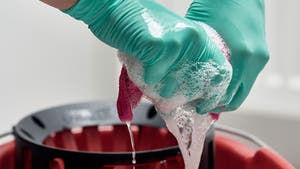Deciphering the Infection Control Challenges Associated with Transmissible Respiratory Infections: A Preventionist Perspective
The following is an abridged article featured in the December 2020 issue of Healthcare Hygiene Magazine (see page 32).
As a healthcare provider that is part of a Regional COVID-19 response team, I have sadly seen the direct and indirect impacts of the ongoing threat posed by COVID-19. Countless lives have been directly or indirectly impacted including those of many healthcare providers at the front lines and healthcare executives charged with leading their organizations during challenging pandemic times. This ongoing pandemic is not expected to cease anytime soon, and the upcoming fall and winter respiratory infections season could potentially produce a new dilemma with concurrently circulating infectious pathogens such as Influenza, RSV, Rhinovirus, and SARS-CoV-2, the novel coronavirus that causes COVID-19. Due to this concurrent circulation of respiratory viruses during the Fall and Winter, it is all the more important for healthcare facilities to not succumb to infection prevention fatigue and maintain an appropriate level of vigilance to the core practices of infection prevention and control.
The Centers for Disease Control and Prevention (CDC) has identified several core recommendations that can dramatically reduce the potential risk for the transmission of respiratory viruses. Below are several key steps that healthcare providers and infection prevention professionals should take to reduce the transmission of infectious respiratory illnesses:
- Rapid Identification of Infectious Diseases: Healthcare facilities must continue to diligently screen their patients, visitors, and staff for potential infectious illness. This screening process should include temperature, symptoms, exposure history, and also travel history.
- Social Distancing: Social distancing practices continue to provide for an additional element of safety by distancing persons from each other, including while in healthcare settings. Social distancing continues to be recognized as one of the simplest and most effective infection control interventions to curb the spread of COVID-19. All healthcare providers, patients, and visitors should wear masks as a universal source control and in accordance with institutional policies for respiratory protection.
- Occupational Health and Illness Recognition: Remaining home from work when ill and away from other people remains an important component of any healthcare facility infection control program. The facility’s human resources department must create a culture of safety by making it “safe” for ill healthcare workers to remain home from work when ill with infectious illnesses without penalty or punitive action. National Programs such as Just Culture can assist healthcare organizational leaders in creating a culture of safety that rewards best practices for safety.
- Routine Hand Hygiene: Simply washing or sanitizing our hands as healthcare providers remains the single most important infection prevention intervention to reduce the potential transmission of Healthcare-Associated Infections (HAIs) and respiratory viruses. This can be accomplished by either washing the hands with soap and water for at least 20 seconds or the use of an alcohol-based hand rub that contains an alcohol formulation between 60-90%.
- Cleaning and Disinfection: Routine cleaning and disinfection of high touch surfaces using an Environmental Protection Agency (EPA)-registered disinfectant will help reduce the potential for indirect transmission of respiratory viruses from environmental surfaces to both healthcare providers as well as patients. It is important to always utilize an EPA-registered, healthcare disinfectant which has broad-spectrum efficacy for a wide variety of pathogens common in healthcare settings. In addition, because of the ongoing threat caused by the SARS-CoV-2, the EPA has released a new List, List N: Disinfectants for Coronavirus (COVID-19), which specifically identifies all current EPA registered disinfectants that are deemed effective against the SARS-CoV-2. Users must carefully follow the disinfectant manufacturer’s instructions for use to ensure safety and efficacy of the product.
- Proper Use of Personal Protective Equipment (PPE): The CDC has provided updated guidance for mitigating the risk of transmission of infectious respiratory pathogens within the current pandemic. This guidance includes the use of respiratory protection, glove, gowns, and eye protection as clinically indicated based on the pathogen of suspicion. It is imperative that healthcare providers not only have access to high-quality PPE, but also are properly trained on the specific PPE equipment’s use in accordance with the manufacturer’s instructions for use. This includes proper donning and doffing procedures to minimize the potential risk for healthcare personnel and environmental contamination.
Each of the steps referenced above plays a pivotal role in reducing the potential transmission of infectious respiratory viruses, keeping patients and healthcare providers safe, and also ensuring the continuity of clinical care operations. Every stakeholder in the healthcare delivery system must play an active role in recognizing and preventing the spread of these common respiratory pathogens. Through interprofessional collaboration, the use of efficacious infection prevention products such as disinfectants, hand sanitizers, and PPE, we can help effectively curb the transmission of respiratory illnesses.
For additional information:
To learn more about the EPA List N, visit: https://www.epa.gov/pesticide-registration/list-n-disinfectants-coronavirus-covid-19.
Dr. Hudson Garrett Jr. is a paid consultant for Clorox Healthcare.


